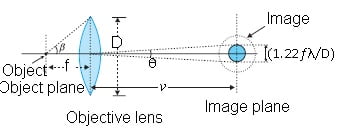Resolving power of Optical Instruments :-
Resolving power of Optical Instruments is the ability of an Imaging device to separate points of an object that are located at a small angular distance or It is the power of an optical instrument to separate far away objects, that are close together into individual images.

Consider a parallel beam of light falling on a convex lens, If the lens is well corrected for aberrations, then geometrical Optics tells us that the beam will get focused to a point.
However, because of diffraction, the beam instend getting focused to a point gets focused to a spot of finite area.
Due to diffraction the pattern on the focal plane would consist of a central bright region surrounded by concentric dark and bright rings.
r₀ = 1·22 λ f / 2a = 0·61 λ f / a
Where f is the focal length of the lens 2a is the diameter of the circular aperture or the diameter of the lens.
The size of the spot is very small, It plays an important role in determining the limit of resolving power of optical instruments like a telescope or a microscope.
For the two stars to be just resolved
f ∆θ = r₀ = 0·61 λ f / a
Thus ∆θ will be a small if the diameter of the Object is large. This implies that the telescope will have better resolving power if ‘a’ is large.
Numerical :-
Assume that light of wavelength 6 x10⁻⁵ cm is coming from a star. what is the limit of resolution of a telescope whose objective has a diameter of 100 inch ?
Solution –
2a = 100 inch = 254 cm
λ = 6 x10⁻⁵ cm
∆θ = ?
∆θ = 0·61 x 6 x 10⁻⁵ / 127 = 2·9 x 10⁻⁷ radians
Resolving Power of a Microscope :-

The object is placed slightly beyond ‘f’ that a real image is formed at a distance ‘V’ , Diameter of the object is D
Then tanβ = D/2 / f
2tanβ = D /f
Where 2β is the angle subtended by the diameter of the Objective lens at the focus of the microscope.
The image of a point Object will again be a diffraction pattern whose size in the image Plane will be
V θ = V ( 1·22λ ) / D
Linear magnification by the lens is
m = V / u = V / f = V θ / d min.
Where d min. is the minimum size of the Object or minimum separation.
d min. = V θ / m = V ( 1·22λ ) / D m
d min. = 1·22λ f / D
since f = V / m
hence d min. = 1·22λ / 2tanβ
since 2tanβ = D / f
For small value of β
tanβ = sinβ
Hence d min = 1·22λ / 2sinβ
If the medium between the object and the objective lens is not air but a medium of refractive index μ
Then we gets modified to
d min = 1·22λ / 2μ sinβ
The resolving power of the microscope is given by the reciprocal of minimum separation of two points seen as distinct.
